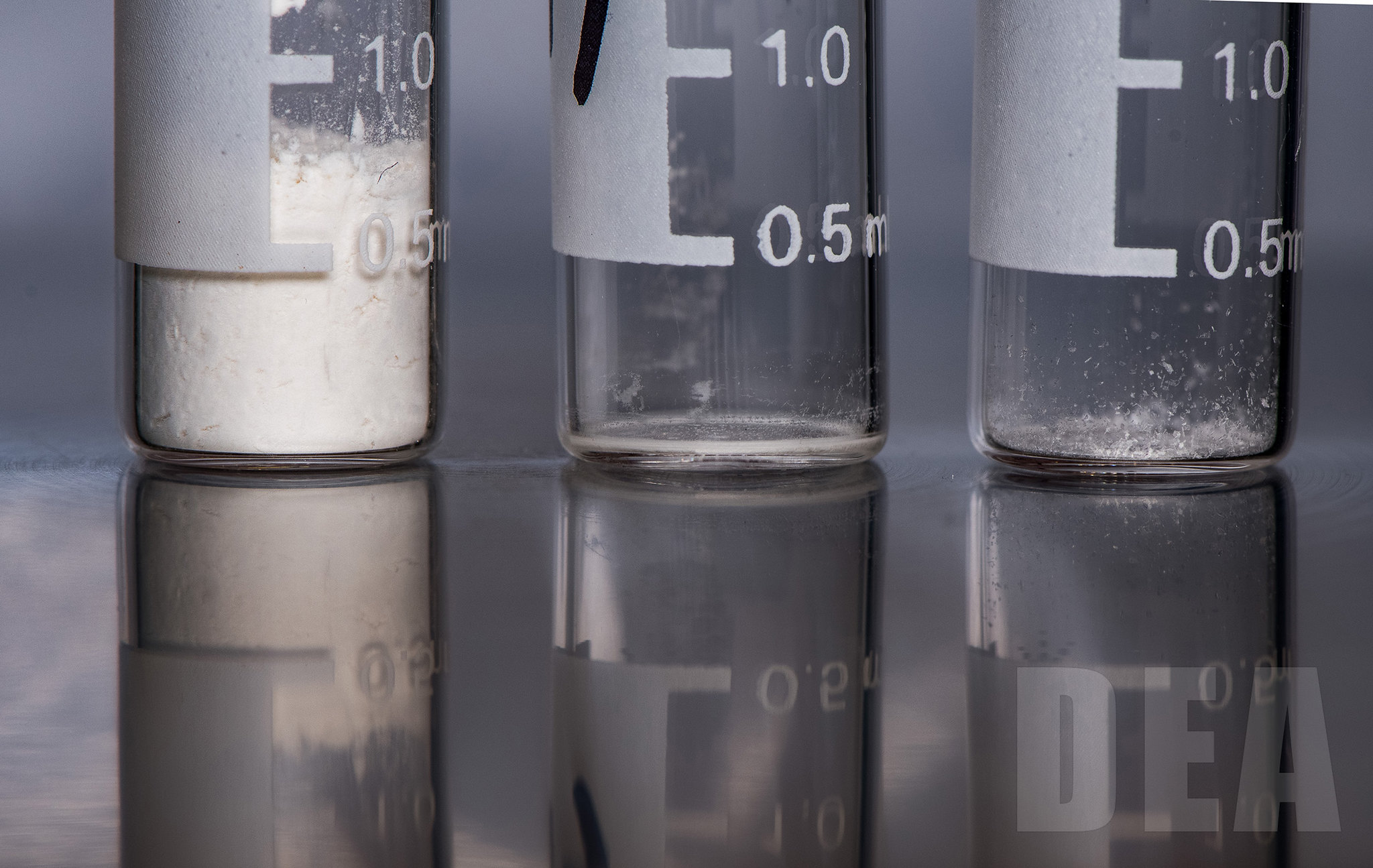The UK government is behind the curve in tracking the spread of new super-strength drugs, a doctor who has treated patients has said.
More than 100 deaths have now been linked to synthetic opioids called nitazenes since the summer, according to the National Crime Agency.
Stronger than heroin and fentanyl
Dr Mark Pucci says flawed data collection methods mean the numbers are a significant underestimate. The drugs are stronger than heroin and fentanyl, a prolific killer in the US.
The National Crime Agency (NCA) believes nitazenes are produced in illicit labs in China and are entering the UK through the Royal Mail and other parcel operators.
Cut and mixed with heroin
In most cases, they are then cut and mixed with heroin by organised gangs, strengthening the drugs being sold on the street.
They have also been found in samples of illegal diazepam tablets, most likely bought online.
Diazepam – also known by one of its brand names, Valium – is a class-C drug in the UK, commonly used to treat anxiety, muscle spasms and seizures. It is illegal to possess without a prescription.
What are nitazenes?
- Nitazenes were first developed in the 1950s as a pain-killing medication but are so potent and addictive they have never been approved for medical or therapeutic use
- Injected, inhaled or swallowed, mixing them with other drugs and alcohol is extremely dangerous and significantly increases the risk of overdose and death
- The new drugs are covered by the Psychoactive Substances Act 2016, but the government said last year it wanted to classify 15 synthetic opioids as Class A drugs
Cross-government taskforce formed
The Department of Health and Social Care (DHSC) told the BBC it was concerned about nitazenes in “fake medicines”.
Alongside law enforcement agencies, DHSC has joined a cross-government taskforce to lead the response.
No national tracking system
Critics, however, say the authorities have not acted fast enough to track non-fatal overdoses involving nitazenes.
Tracking overdose data can show where the drugs have spread and predict and prevent deaths.
Currently, there is no national system. Overdose figures are gathered by the government from local services and are based on tests of seized drugs and paraphernalia or samples from drug users.
Those records, obtained by the BBC through a Freedom of Information request, suggest there were four non-fatal nitazene overdoses across the West Midlands in the last six months of 2023.
Overdose survivors
However, Dr Mark Pucci, a consultant in clinical toxicology who works in Birmingham and Sandwell, however, observed 13 patients who overdosed and survived between July and October 2023.
They were among 19 people who tested positive for the drugs in blood or urine tests. None of the patients knew beforehand they had taken them.
He said,
“I believe there are very few NHS labs around the country that are set up to test for nitazenes.
“I do believe England is behind the curve on this matter and is now playing catch up. The data collection method they are using in terms of testing drug paraphernalia and so on is only ever going to be the tip of the iceberg.”
Other data
A BBC Shared Data Unit investigation has also found:
- There have now been 101 deaths linked to nitazenes across the UK from when health bosses began recording in June last year. Seventy-six of them were in England, with the most recent in York in January. At least a further 49 cases await further testing.
- Between June and December last year, the Department of Health and Social Care recorded 19 non-fatal overdoses across England linked to nitazenes.
- The drugs are also being trafficked from the UK overseas to New Zealand, Australia and the US, the National Crime Agency has said.
- The DHSC is consulting on a legal change so more professionals can give out take-home supplies of naloxone – a medicine that can reverse the effects of an opioid overdose.
- Most of the 58 samples submitted voluntarily to Public Health Wales’s drug testing service, Wedinos, which were found to contain nitazenes between June last year and February, were from people who had intended to buy Benzodiazepines such as Diazepam.
Advice to Gov not followed
Dr Judith Yates, who collates data about drug deaths in Birmingham, said advice to government published in 2016 had not been followed, which suggested focusing more on non-fatal overdoses, which were often a warning of future deaths.
No heroin shortage in the UK
One reason thought to be behind the emergence of these new drugs is the ban of harvesting opium poppies in Afghanistan.
The NCA says at this stage there is not a heroin shortage in the UK as there remain significant reserves. A spokesman said the purity of street-level heroin had declined in the last year as part of a long-term trend.
Targeting key offenders
The agency has worked with police across the UK and internationally to target key offenders including those selling on dark net markets. All areas had testing facilities, but due to nitazenes’ novelty, resources were limited.
The number of deaths involving nitazenes was “likely… under-represented”, in part due to “information gaps” within the UK drugs market.
The DHSC said it had a surveillance system in place to collect information on the nature and location of novel drug use. Work was under way to improve these systems including collating information from ambulance call-outs and hospital admissions.
Pucci: I do believe England is behind the curve on this matter and is now playing catch-up
Dr Mark Pucci, who treated the first person in the UK found to have taken a nitazene in July 2021, is a consultant for the National Poisons Information Service (NPIS) and observed 13 patients who overdosed and survived between July and October 2023 among 19 who tested positive for the new drugs in blood and urine tests.
He said,
“As you can see from our data, 7.4% of the unknown drug screens carried out during the study period (July to October 2023) was positive for N-desethyl isotonitazene.
“I believe there are very few NHS labs around the country that are set up to test for nitazenes. In Birmingham, we are lucky to have excellent labs in both City Hospital and Heartlands Hospital.
“I am unsurprised that OHID has not been tracking non-fatal overdoses as there hasn’t been a system in place that I am aware of for them to do so. Surveillance for NPS [novel psychoactive substances] in the UK has been reliant on a number of different sources, including the IONA study (previously funded by PHE and NIHR, now discontinued), Wedinos in Wales, published individual case reports or case series, the EMCDDA and more recently the RADAR system in Scotland.
“I do believe England is behind the curve on this matter and is now playing catch-up. The data collection method they are using in terms of testing drug paraphernalia and so on is only ever going to be the tip of the iceberg.”
Mack: Local testing needs support from Police and Home Office
Charlie Mack, chief executive of the charity Cranstoun, says there have been new spikes in London, Greater Manchester and Belfast, as well as other areas.
“There is a lack of a national, coordinated data collection on this, which is hindered by the lack of permission for local areas to provide drug checking services.
“We’ve identified the need for these services which would allow local areas to lead testing supported by arrangements with police and the Home Office. This testing would allow for meaningful early-warning systems and let local bodies respond quickly to these situations and more timely gathering of intelligence on threats as they emerge.”
Mack: “Hundreds of times stronger than heroin”
He added,
“Some nitazenes can be hundreds of times stronger than heroin, so the risk they pose is huge. That is why we provide advice to people we work with who use heroin that they should test a small amount first, as their normal dose is very likely to have severe consequences if it turns out to be a synthetic opioid.
“We’ve worked really closely with other providers of drug treatment from right across the country on a unified message and approach, this has included encouraging people who use our services to create a Stayin’ Alive plan, which they can carry with them at all times, we have been providing double the amount of naloxone to people who may come into contact with nitazenes.
“We have also been encouraging people who use drugs alone to access the ‘BuddyUp’ phone app which allows them to anonymously speak to one of our call handlers, who can alert emergency services if they become unresponsive.”
What are the signs someone has taken them?
- Small, narrowed pupils
- Reduced or loss of consciousness
- Dizziness or drowsiness
- Difficulty breathing
- Nausea or vomiting
- Cold or clammy skin
- Blue or grey lips and fingernails
- Low blood pressure or decreased heart rate
Anyone who has consumed synthetic opioids and experiences the symptoms described should seek urgent medical treatment.
IW data
News OnTheWight has asked IW Public Health whether any deaths of overdoses have been recorded due to nitazenes.
A spokesperson for Isle of Wight Public Health replied,
“The UK National Crime Agency reports on drug deaths or overdoses where nitazenes were detected in post-mortem toxicology.”
“While Public Health do not hold this information, it is aware of these dangerous synthetic opiates. Together with partners, we continue to raise awareness of the dangers of drug use through coordinated harm reduction efforts, and ensuring people know how to access support and treatment for themselves, their family, or friends.
“We encourage them to contact their local treatment provider to get the support that is available to them.”
Find details of support services on the Isle of Wight.
Article edit
1.40pm 20th Mar 2024 – Comment from PH added
News shared by the BBC Shared Data Unit as part of the Local Democracy Reporting Scheme. Ed





